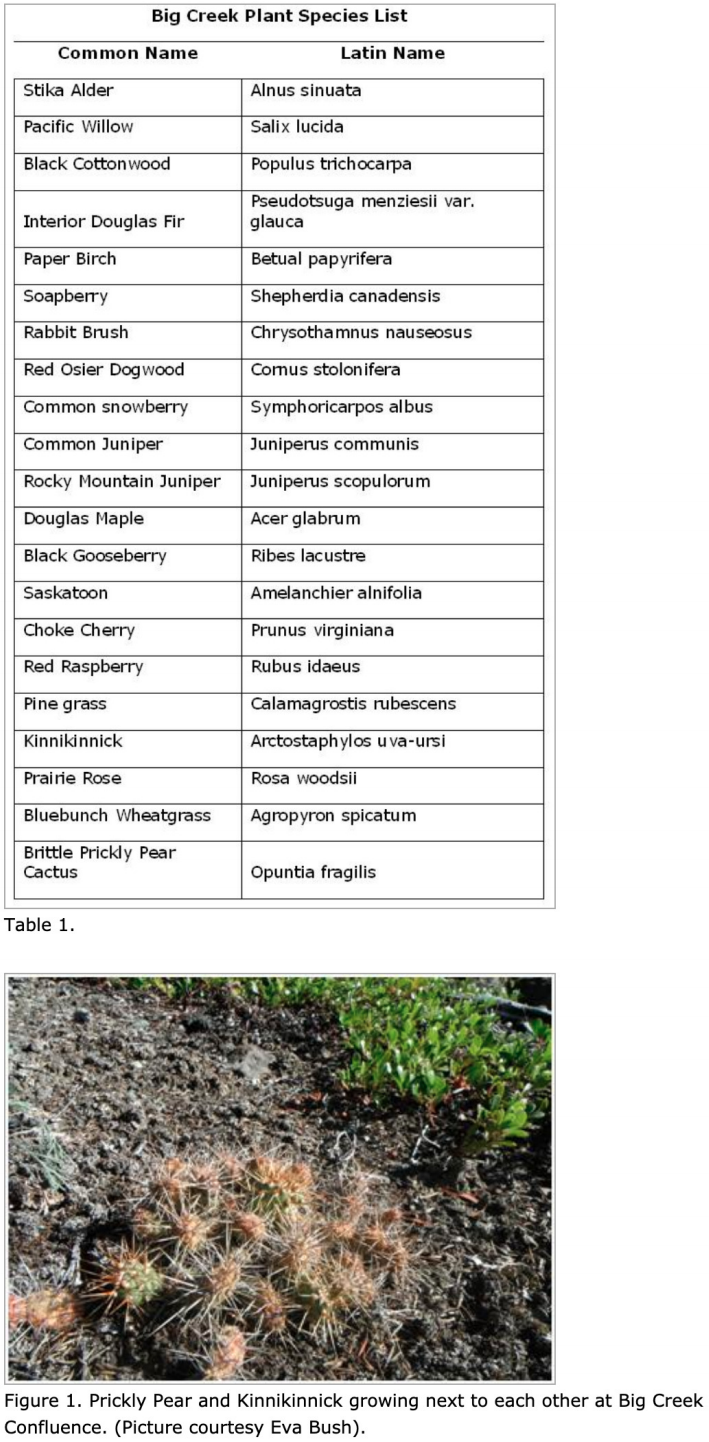The Chilko-Chilcotin River has its headwaters at the edge of the coastal mountains of British Columbia. As the river flows across the interior plateau of BC the rain shadow effect increases in severity giving rise to a dramatic transition in plant community composition of the regional forest surrounding the river. At Chilko Lake, the forest is dominated by Lodgepole Pine (Pinus contorta), and to a lesser extent White Spruce (Picea glauca), Grand Fir (Abies grandis), Ponderosa Pine (Pinus ponderosa), and Interior Douglas Fir (Pseudotsuga menziesii var. glauca) with an understory of feathermoss. This region is currently decimated by the Mountain Pine Beetle (MPB) outbreak and frequent fire activity. The regional forest transitions to a plant community dominated by Interior Douglas fir as you enter Hanceville Canyon. Interior Douglas Fir is a subspecies of the Douglas Fir found in the coast range. The Interior variety is drought tolerance and smaller in size with needles that are blueish-green in color. Douglas Fir is easily distinguished from other conifers in the region by its seeds, which exhibit bracts that have three points at the ends.
In this region tree species have either a flight or fight strategy in response to the frequent fires in the region. Lodgepole pine makes friends with fire. The tree has serotinous cones; this means the cones are closed with a resin, which requires intense heat from fire to melt the resin, open the cones, and release the seeds. After a fire, Lodgepole Pine creates a blanket of seedlings across the forest floor. Densities of seedlings can be upward of 100,000 seedlings per hectare! (Parish et al 1996). After roughly 100 years, Lodgepole Pine stands begin to self thin, creating a fuel complex which encourages the spread of intense fire. Additionally Lodgepole Pine has thin bark and are quickly killed by fire damage. The epidemic levels of the MPB outbreak in the region is increasing the production of dead Lodgepole Pine on hillslopes. Interior Douglas Fir has a fight strategy in response to fire. The tree has thick bark, which is resistant to fire and sheds its lower branches quickly, preventing the creation of a fuel ladder to the top of the canopy. Tree species that are resistant to fire tend to dominate later in forest succession. This suggests the lower reaches experience less frequent fires, but rather small-localized fires.
The transition to Interior Douglas Fir dominated forest is noticeable as the river runs through Hanceville canyon. The northern slope on river right is blanketed in Douglas Fir with the occasional gap either created by avalanches in the winter or localized fires events likely sparked by summer lightening events. On river left, the vegetation is dominated by Douglas Fir, however, with a spares distribution. There are also more pockets of Junipers and Rabbit Brush, two drought tolerant species. This is the more southern exposed slope and is thus exposed to more solar isolation creating drier conditions. Additionally the soils are developing on well drained glacial till except for pockets of exposed bedrock.
The campground at Big River creek is located on an old debris flow carrying boulders and glacial flour from the Big Creek canyon. Interior Douglas Fir dominates the canopy of the debris flow both because of the dry climate and due to the dominance of this species in the regional species pool. The debris flow is an example of primary succession. After the material was deposited, likely in one catastrophic event, vegetation began to disperse from the regional species pool and colonize the bare surface. The seeds of Douglas Fir could have also been carried with the debris flow given the hillslope of Big Creek canyon is blanketed in Douglas Fir. Evidence of this is found on younger debris flows were Douglas Fir is found growing out between large boulders without any evidence that the rocks moved around the growing tree (both on the tree nor disturbance in lichen growth on exposed rock surfaces.
Big Creek-Chilcotin Confluence is transition point from the wetter conditions upstream to the increasingly drier conditions as the river cuts deeper canyons into the interior plateau. As a result Big Creek has vegetation that is both found along the whole stretch of the river or only upstream or downstream. For example, both kinnikinnick (Arctostaphylos uva-ursi) a small shrub less than 20cm in height producing bright red berries is found growing next to a desert species, Prickly pear (Opuntia fragillis)(Pictured below). The species found in the driest parts of the interior plateau are found on the highest points of the debris flows. This includes Interior Douglas Fir, Rabbit Brush, Common Juniper, Rocky Mountain Juniper, and Prickly Pear. Along the edges of the debris flow were it meets the river can be found Alder, Willow, and Cottonwood. The understory closer to the edges of the debris flows can be found soapberry, red osier dogwood, common snowberry, kinnikinnick, choke cherry, and Saskatoon. The soapberry is similar to alder in that it is also a symbiotic nitrogen fixing plant able to increase the nitrogen pool of the soils surrounding it. Soapberry is able to persist in drier conditions than alder. The attached species list indicates a complete list of the vegetation found at the Big Creek Confluence.

